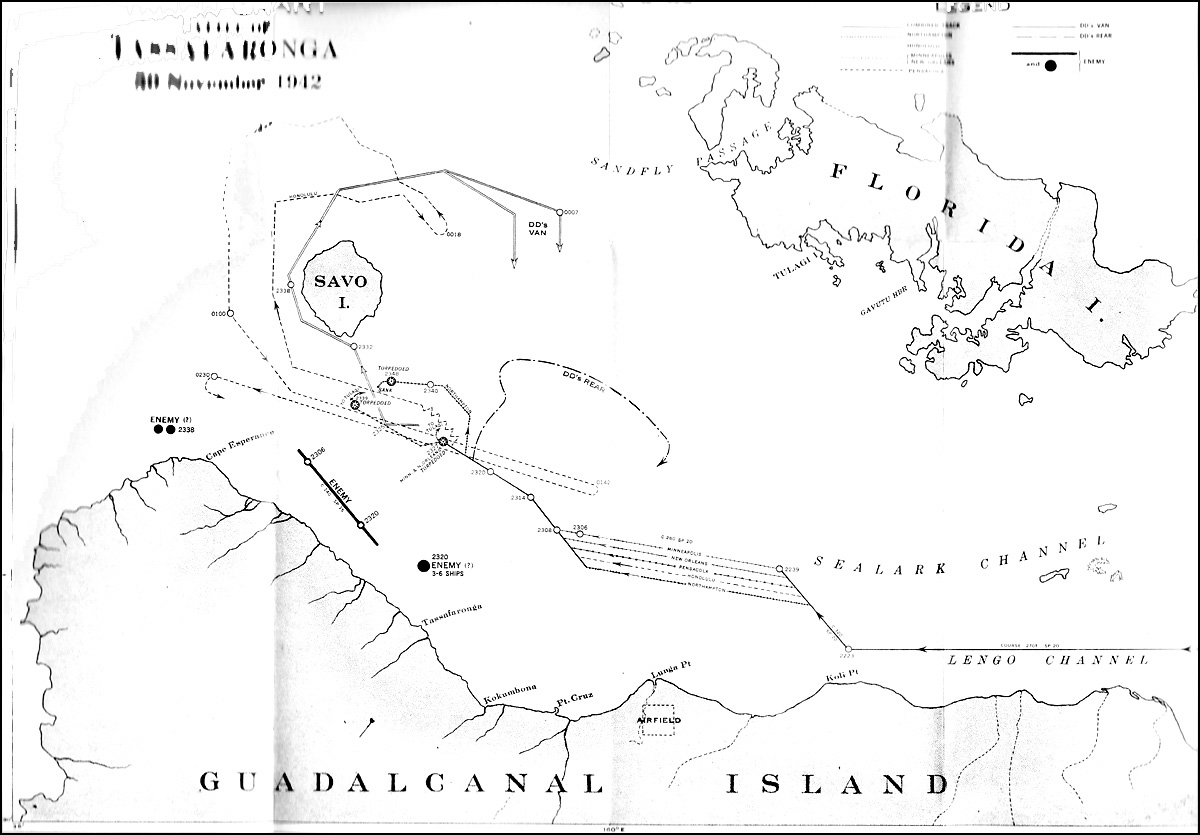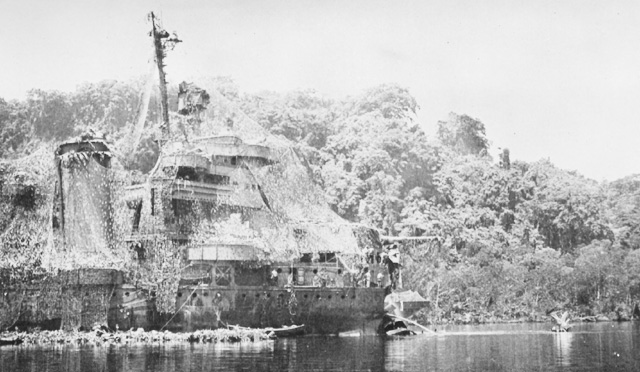Japan had resorted to submarines because they were unable to rely on surface ships. A combination of US aircraft operating from Henderson Field on Guadalcanal, US PT Boats operating from Tulagi and US surface warships had prevented Japanese resupply operations by ship.
The Japanese developed a new plan. Resupply by high speed destroyers carrying floating drums of food and medical supplies. The drums, connected to each other by line, were to be carried on the decks of six destroyers, escorted by two more. The destroyers would approach at high speed, drop the drums overboard and return to base. Soldiers would swim out and recover the drums.
Following the Naval Battle of Guadalcanal, Admiral Halsey, Commander of the Southern Pacific Command, reorganized his surface warfare forces, forming a new Task Force, TF 67, at Espiritu Santo in the New Hebrides, about 580 miles from Guadalcanal. The Task Force, initially under RADM Kinkaid, was reassigned to RADM Carleton H. Wright on November 28.
TF 67's job: intercept and destroy any Japanese surface force coming to the aid of Japanese forces on Guadalcanal.
The U.S. victory at the Battle of Guadalcanal had cost Halsey 18 ships sunk or so badly damaged that extensive repairs were required. With the exception of destroyers, Halsey's only available surface units were the carrier Enterprise, the battleship Washington, and the light cruiser San Diego at Noumea and the heavy cruisers Northampton and Pensacola at Espiritu Santo.
Several other ships were en route to the South Pacific. By 25 November, as intelligence was piecing together a clearer picture of Japanese plans, Halsey had assembled a force adequate to counter the expected offensive. At Nandi in the Fijis lay the carrier Saratoga, the battleships North Carolina, Colorado, and Maryland, and the light cruiser San Juan. The heavy cruisers New Orleans, Northampton, and Pensacola, and the light cruiser Honolulu were stationed at Espiritu Santo. These last two, together with the heavy cruiser Minneapolis which arrived on the 27th, had come from Pearl Harbor. Here also on the 27th were the destroyers Drayton (which had accompanied the Minneapolis), Fletcher Maury, and Perkins.
On 27 November, these 5 cruisers and 4 destroyers at Espiritu Santo were grouped in to a separate task force, Task Force William, under the command of Rear Admiral Thomas C. Kinkaid, with general instructions from Halsey to intercept any Japanese surface forces approaching Guadalcanal. Admiral Kinkaid prepared a detailed set of operational orders for the Force, but, before he could go over them with his captains, he was ordered to other duty. He was replaced by Rear Admiral Carleton H. Wright, who had just made port in the Minneapolis.
Task Force William consisted of four heavy cruisers: Minneapolis, New Orleans, Northampton and Pensacola. Admiral Wright was embarked in Minneapolis;
One light cruiser: Honolulu, with RADM Tisdale embarked; Four destroyers: Drayton, Fletcher, Maury, Perkins. USS Fletcher was the fleet's newest and most powerful destroyer. Her CO, Commander William M. Cole, was in charge of the destroyer unit.
On 29 November the Task Force was moored at Espiritu Santo on 12 hours notice for getting underway. Admiral Wright held a conference, attended by Admiral Tisdale and the commanding officers of the 9 ships, at which the operation plan drawn up by Admiral Kinkaid was "briefly discussed."
At 1940 Admiral Wright received orders to prepare to depart with his force at the earliest possible moment, and to proceed at the best possible speed to intercept an enemy group of 6 destroyers and 6 transports which was expected to arrive off Guadalcanal the next night. He directed Task Force WILLIAM to make all preparations necessary to get under way immediately, and advised COMSOPAC that his ships would be ready to sortie at midnight.
Three hours later COMSOPAC ordered Admiral Wright to proceed with all available units, pass through Lengo Channel (between Guadalcanal and Florida Islands), and intercept the Japanese off Tassafaronga on the northwestern shore of Guadalcanal. Later, Admiral Wright received information that enemy combatant ships might be substituted for the transports, or that the Japanese force might consist wholly of destroyers, and that a hostile landing might be attempted off Tassafaronga earlier than 2300, 30 November. He received no further advices respecting the size or composition of the opposing units.
Admiral Wright promptly put into effect, with minor modifications, Admiral Kinkaid's operation plan, and set midnight as the zero hour for his ships to sortie. Actually the destroyers got under way at 2310, the cruisers at 2335. The whole Force cleared the well-mined, unlighted harbor of Espiritu Santo without incident and shaped its course to pass northeast of San Cristobal Island.

Task Force WILLIAM cleared Lengo Channel at 2225 at a speed of 20 knots. Its average speed made good from midnight, 29 November, when it left Espiritu Santo until it entered Lengo Channel at 2140, 30 November, was 28.2 knots. The cruisers steamed in column, 1,000 yards apart, while the destroyers in the van bore 300° T., 4,000 yards from the Minneapolis. The night was very dark, the sky completely overcast. Maximum surface visibility was not over 2 miles.
Admiral Wright had prepositioned sea planes from the cruisers at Tulagi. Their instructions were to take off in time to patrol the area between Cape Esperance and Lunga Point starting at 2200. They carried flares to drop at Admiral Wright's command. The rest of Admiral Wright's plan depended on using the Navy's new SG surface search radar to gain the advantage of surprise. The four destroyers were in the van (ahead), followed by the cruisers steaming in column 1,000 yards apart. Two additional destroyers, Lamson and Lardner, joined the force at 2100, bringing up the rear. Lamson's CO, Commander Abercrombie, was senior to Cole, but had no copies of the plan, no surface radar, and no knowledge of what was going on. He was therefore unable to assume command of the destroyer force.
At 2306, Minneapolis' SG radar picks up two objects off Cape Esperance. At 2316, Cdr Cole, in accordance with the plan, requested permission to launch torpedo attack on enemy formation of 5 ships, distant 7,000 yards.
About 2321, Admiral Wright ordered ships to commence firing star shells (for illumination) and explosive shells. Apparently TF 67 had caught the Japanese by surprise. The force engaged eight Japanese destroyers or cruisers using fire control radar for aiming. After a few minutes, four of the radar targets disappeared from the radar and some were visually seen to explode and sink.
There was some confusion in attempts to correlate ranges and bearings of Japanese ships, but as of 2326, it appeared that TF67 had won a great victory.
At 2327 a Japanese torpedo struck Minneapolis', blowing off her bow. The ship kept firing until her engineering plant failed and lost power. At 2328, New Orleans was torpedoed, losing her bow as far aft as Turret II. At 2329, a torpedo struck Pensacola on the port side aft, the ship erupted in flames, and fire raged for hours. At 2348, Northampton was torpedoed. Despite valiant efforts to save her, she finally sank about 0300.
Thus, within a few minutes, what had seemed a great victory turned into a resounding loss. One US heavy cruiser sunk, three out of action for months, 395 sailors killed.
As it turned out, only one Japanese destroyer was lost and 197 killed.
Even so, TF67 succeeded in preventing Japanese resupply of their troops on Guadalcanal.
The battle revealed continuing shortcomings in the use of radar.
The surface force was not yet aware that reliability problems affecting submarine torpedoes also applied to those launched by surface ships. Corrective action was many months away.
But damage control and firefighting crews performed magnificently. It is almost inconceivable that Minneapolis, New Orleans and Pensacola were saved and lived to fight another day.

New Orleans at Tulagi

Minneapolis at Tulagi
The US Navy still did not know how powerful and effective Japanese type 93 surface-launched torpedoes were. Admiral Wright, in his after action report, still thought the sips had been torpedoed by undetected submarines. There were, after all, no Japanese surface ships within what we believed to be torpedo range.
We would not learn of their technological superiority until later in 1943, when intact torpedoes were captured.




No comments:
Post a Comment